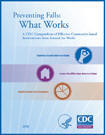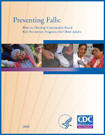
We want a society where older adults can live to their full potential. While falls are a threat to the health and independence of older adults and can significantly limit their ability to remain self-sufficient, the opportunity to reduce falls among older adults has never been better. Today, there are proven interventions that can reduce falls and help older adults live better, and longer.
 Preventing Falls: What Works
A CDC Compendium of Effective Community-based Interventions from Around the World
Preventing Falls: What Works
A CDC Compendium of Effective Community-based Interventions from Around the World
This compendium of interventions is designed for public health practitioners and community-based organizations, to help them address the problem of falls among older adults. It describes 14 scientifically tested and proven interventions, and provides relevant details about these interventions for organizations who want to implement fall prevention programs.
The interventions are grouped into three categories: 1) exercise-based, 2) home modification, and 3) multifaceted. Each intervention description includes a short summary of the research study and results, as well as a longer section describing the intervention. Descriptions include information about the following:
- Focus of the intervention
- Setting
- Content
- Number of sessions
- Duration
- Provider and provider’s training
- Available intervention materials
- Contact information for the study’s principal investigator
This document also includes appendices with useful charts and tables, assessment instruments, and evaluation materials.
View, download or print the full text of
Preventing Falls: What Works
A CDC Compendium of Effective Community-based Interventions from Around the World. ( ![]() 14.5MB, 102 pages)
14.5MB, 102 pages)
 Preventing Falls: How to Develop
Community-based Fall Prevention Programs for Older Adults
Preventing Falls: How to Develop
Community-based Fall Prevention Programs for Older Adults
This “how-to” guide is designed for community-based organizations who are interested in developing their own effective fall prevention programs. This guide is designed to be a practical and useful tool, and it provides guidelines on program planning, development, implementation, and evaluation.
In this document, CDC provides organizations with the building blocks of effective fall prevention programs by providing examples, resources, and tips. Program components described in the guide include the following:
- Education
- Exercise programs
- Medication management
- Vision checking and improvement
- Home hazard assessment and modification
This guide also includes helpful information on building and maintaining community partnerships and promoting, evaluating, and sustaining fall prevention programs. The appendices include practical assessments, worksheets, presentations, and templates.
View, download or print the full text of
Preventing Falls: How to Develop Community-based Fall Prevention Programs for Older Adults. (![]() 2.52MB, 100 pages)
2.52MB, 100 pages)
To order these materials at no cost, click here
Contact Us:
- Centers for Disease Control and Prevention
National Center for Injury Prevention and Control (NCIPC)
4770 Buford Hwy, NE
MS F-63
Atlanta, GA 30341-3717 - 800-CDC-INFO
(800-232-4636)
TTY: (888) 232-6348
24 Hours/Every Day - cdcinfo@cdc.gov

